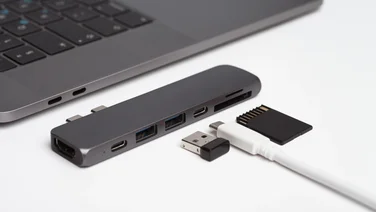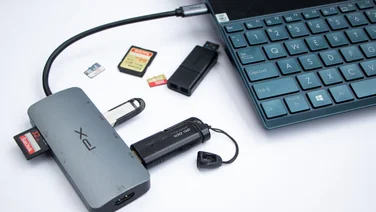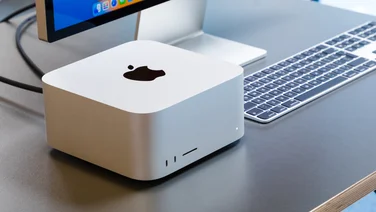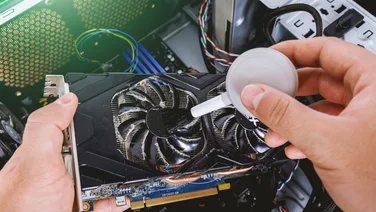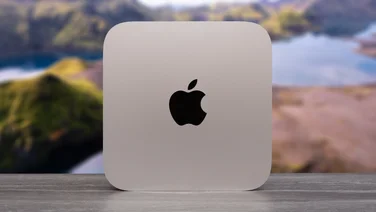To help us provide you with free impartial advice, we may earn a commission if you buy through links on our site. Learn more
- How to buy the best mini PC for you
- The best mini PCs you can buy in 2021
- 1. Raspberry Pi 4 Model B: The best mini PC for hobbyists
- 2. Asus Mini PC PN50: The best barebones mini PC
- 3. Minix Neo JS0C-4: The best budget Windows 10 mini PC
- 4. Asus Tinker Board: A rare alternative to the Raspberry Pi
- 5. M1 Apple Mac mini: The best mini Mac
- 6. Raspberry Pi Zero W: The smallest, cheapest mini PC there is – yet surprisingly capable

As great as beefy desktop PCs are, there’s one problem: their size. Compared to other computing devices such as smartphones and laptops, PCs take up an awful lot of room. Even many compact designs can struggle to fit beneath a monitor or TV, and portability isn’t even considered.
Fortunately, there’s an alternative, and we don’t mean spending the premium for a laptop. Mini PCs replicate the full-sized desktop experience in truly tiny form factors. Some use laptop components such as low-power processors – but because you’re not paying for an attached display or keyboard, the mini PC as a whole is generally considerably cheaper.
If you’re looking for a space-saving computer, you’ve come to the right place. Here are the best mini PCs on the market – some running Windows, others ready for you to install the OS of your choosing. Best of all, the prices are tiny, too.
How to buy the best mini PC for you
“Mini PC” is something of an umbrella term covering a few distinctive types of product. One subspecies is the board-only PC, otherwise known as a microcomputer or maker board. Whatever you want to call it, it’s essentially a petite motherboard with attached system-on-a-chip (SoC). With various connectors and ports, and potentially a spot of soldering, these can be transformed into almost anything you want, from a home media computer running Android to the brains of a remote-controlled robot. Their versatility and very low cost make these boards understandably popular with the maker community.
For those who want a better approximation of a desktop PC, there’s a large selection of mini PCs designed to run Windows. These are much closer to the desktops and laptops we’re familiar with and support proper SSDs and hard disks, upgradeable RAM and a wide range of external ports. There are options here, too, though: you can buy a ready-made system or opt for a so-called “barebones box”, to which you add the RAM, storage and operating system yourself. It’s a little extra inconvenience in exchange for more choice and control.
How much power?
Whichever mini PC you go for, you’ll need enough processing power to perform what needs doing. Maker boards tend to feature lightweight ARM-based processors, which are fine for browsing the web but might struggle with more demanding jobs.
Windows-based mini PCs often feature more powerful processors – sometimes the same ones you’ll find in laptops, which means they can accommodate some very powerful chips indeed. Of course, you’ll end up paying a lot more for this sort of hardware.
What about graphics?
Most mini PCs only have room for the integrated graphics on their existing processor, rather than a separate GPU, so it’s rare to find one with serious gaming capability. Options do exist with discrete graphics, though – such as the Asus VivoMini, below – which can help with productivity tasks like image and video-editing. It’s something to keep in mind if you’re looking for a tiny workstation.
How much storage do I need?
Solid-state storage is a natural fit for mini PCs as it’s lighter and far more compact than traditional hard disk technology. On tiny maker boards, this might be in the form of a microSD card, in which case shop around for a fast card as a cheap, slow one will drag down performance.
As you move upmarket, you might see mini PCs with small eMMC flash drives built in. Spend a bit more and you can potentially have a large, capacious system drive. It’s normally a good idea to aim for as much storage as your budget allows because it’s a pain to replace a drive once you’ve installed your operating system and apps on it.
READ NEXT: The 10 best laptops you can buy
The best mini PCs you can buy in 2021
1. Raspberry Pi 4 Model B: The best mini PC for hobbyists

Price: £34 | Buy now from The Pi Hut
The Raspberry Pi series has been the last word in tiny project computers for years, and the latest Pi 4 Model B is yet another triumph. This time, the Pi Foundation has tried to make it more of a viable desktop PC, without losing any of the flexibility that made its predecessors so appealing to makers.
Everyone will benefit from the more powerful CPU, of course, but combined with the added dual 4K monitor support (courtesy of two micro-HDMI ports), it’s a big boost to the Pi 4’s desktop credentials. Two of the four USB ports also now support Super Speed USB 3, Wi-Fi uses the faster 802.11ac standard instead of 802.11n, and even the power connector has been upgraded to a USB Type-C port.
If the default 2GB of RAM sounds like too little for use as your main computer, 4GB and 8GB variants are also available – although for projects it’s heartening to see the basic version is still sold at a very affordable £34.
Read our full review of the Raspberry Pi 4 Model B
Key specs – Operating system: Raspbian (recommended); Processor: Quad-core 1.5GHz Broadcom BCM2711; RAM: 2GB (max 8GB); Supplied storage: None; Data connectors: 2 x USB 2, 2 x USB 3, 1 x 40-pin GPIO; Video ports: 2 x micro-HDMI; Networking: 802.11ac Wi-Fi, 10/100Mbit/sec Ethernet; Dimensions: 19 x 57 x 86mm (HWD); Warranty: One year RTB
2. Asus Mini PC PN50: The best barebones mini PC

Price: £320 | Buy now from Ebuyer
As per barebones tradition, the PN50 isn’t quite as dirt-cheap as the initial outlay suggests, since you’ll need to supply your own storage, operating system and SO-DIMM RAM sticks. Once that’s all sorted, however, you’ll be left with a remarkably powerful yet extremely tiny PC that’s more than capable of everyday computing duties.
Its processor, a brand-new Ryzen 5 4500U, blows away the likes of the Minix Neo JS0C-4 on both single-core and multithreaded performance, and its integrated graphics can even handle some light gaming. Dirt: Showdown ran at a playable 30fps at 1080p, even with graphics settings on Ultra.
Even better is the PN50’s connectivity. As well as multiple USB-C ports (which can carry video as well as data), Bluetooth 5.0 and 802.11ax Wi-Fi are both built in. That makes the PN50 one of the first PCs, of any form factor, to support Wi-Fi 6 out of the box.
Key specs – Operating system: None (Windows 10 recommended); Processor: Hexa-core 2.3GHz AMD Ryzen 5 4500U; RAM: None (max 64GB); Supplied storage: None; Data connectors: 3 x USB 3, 2 x USB-C; Video ports: 1 x HDMI, 1 X DisplayPort, 2 x USB-C; Networking: 802.11ax Wi-Fi, Gigabit Ethernet; Dimensions: 49 x 115 x 155mm (HWD); Warranty: One year RTB
3. Minix Neo JS0C-4: The best budget Windows 10 mini PC

Price: £270 | Buy now from Amazon
Chinese manufacturer Minix might not have the clout of Asus or Acer, but it knows how to make a good mini PC on the cheap. The Neo JS0C-4 is no barebones system, either – it comes with storage, memory and Windows 10 included, so it’s ready to go straight out of the box.
Paying this little for a full Windows PC does require tempering your expectations a bit. So, the Intel Pentium processor is mainly only comfortable with basic tasks and the storage – a 64GB Flash drive – is both slower and smaller than most basic SSDs. Still, it performs well enough for the price, and its simple, squat design is lovely. It’s practical, too, as you can VESA-mount the whole thing.
Connectivity is good, with enough USB ports for multiple peripherals alongside built-in 802.11ac Wi-Fi. Plus, if you want to upgrade the RAM or storage yourself, it’s simply a matter of removing the base and adding components to the exposed slots beneath.
Key specs – Operating system: Windows 10 Home; Processor: Quad-core 1.5Ghz Intel Pentium Silver J5005; RAM: 4GB (max 16GB); Supplied storage: 64GB eMMC; Data connectors: 3 x USB 3, 1 x USB Type-C; Video ports: 1 x HDMI, 1 x mini DisplayPort, 1 x USB Type-C; Networking: 802.11ac Wi-Fi, Gigabit Ethernet; Dimensions: 26 x 290 x 290mm (HWD); Warranty: One year RTB
4. Asus Tinker Board: A rare alternative to the Raspberry Pi

Price: £60 | Buy now from Amazon
The Tinker Board is Asus’ rival to the Raspberry Pi series. The physical dimensions and connectors are identical, meaning you can fit it into most Raspberry Pi cases, but it has several advantages, including Gigabit Ethernet and an upgradeable IPEX antenna header to boost wireless performance.
Perhaps more importantly, the Tinker Board’s 2GB of RAM is double that of the Pi 3 and the same as that of the base Pi 4, while a more powerful Rockchip Quad-Core RK3288 processor provides almost double the Pi’s performance. Graphics performance is also better: while we wouldn’t suggest you try playing games on the Tinker Board, it has integrated H.265 decoding so it can play 4K video.
The Linux-based TinkerOS is open-ended enough to let you use the Tinker as a desktop computer, but it’s really designed for projects – and most Pi code can be translated to run with only minor modifications. If you’re feeling held back by the hardware limitations of the Raspberry Pi 3, it’s a superb little upgrade – and still very cheap.
Read our full review of the Asus Tinker Board
Key specs – Operating system: TinkerOS/Android 6.0; Processor: Quad-core 1.8GHz Rockchip RK3288; RAM: 2GB (max 2GB); Supplied storage: None; Data connectors: 4 x USB 2, 40-pin GPIO; Video ports: 1 x HDMI; Networking: 802.11n Wi-Fi, Gigabit Ethernet; Dimensions: 19 x 85 x 53mm (HWD); Warranty: Three years RTB
5. M1 Apple Mac mini: The best mini Mac

Price: £699 | Buy now from Amazon
This much-loved compact PC gets a processor overhaul with Apple’s new M1 chipset, making the M1 Apple Mac mini a very impressive piece of kit. It delivers a huge amount of performance per pound and is, by Apple’s standards, relatively affordable. At £699 for the base model with 8GB of RAM and a 256GB SSD, you’re getting plenty of top-notch hardware for your money.
A fast, unobtrusive, quiet PC, the M1 Apple Mac mini measures a mere 197 x 197 x 36mm (WDH) and weighs around 1.2kg. For its size, it comes with a strong set of outputs and inputs: a pair of USB-A 3.1 Gen 2 (up to 10Gbits/sec) ports, two Thunderbolt 4/USB 4 USB-C ports, one HDMI 2.0 video output, plus a 3.5mm headphone jack and a Gigabit Ethernet socket for networking. As for wireless connectivity there’s Wi-Fi 6 and Bluetooth 5.
In terms of power, you’re getting M1 MacBook Pro performance from the Mac mini for £300 less than a MacBook Air, which is very impressive indeed. You probably won’t want to get a M1 Apple Mac mini for graphically intense video games, but for a home office the M1 Apple Mac mini is a fantastic, compact computer.
Read more in our full M1 Apple Mac mini review
Key specs – Operating system: Mac OS; Processor: Apple M1; RAM: 8-16GB; Supplied storage: 256GB – 2TB; Data connectors: 2x USB-A 3.1 Gen 2, 2x Thunderbolt 4/USB 4 USB-C ports; Video ports: One HDMI 2.0; Networking: Wi-Fi 6, Bluetooth 5; Dimensions: 197 x 197 x 36mm; Warranty: One year RTB
6. Raspberry Pi Zero W: The smallest, cheapest mini PC there is – yet surprisingly capable

Price: £10 | Buy now from The Pi Hut
The Pi Zero W is a tiny thing, measuring just 5 x 65 x 30mm. Yet, it’s a fully working computer with integrated Bluetooth and 2.4GHz 802.11n Wi-Fi.
The small size means there’s no room for full-sized ports, but there’s a micro-USB On-The-Go (OTG) port for connecting devices, and a mini-HDMI output – and the Pi’s trademark 40-pin general input/output (GPIO) connector is here too, although you’ll need to solder the pins on yourself if you want to use it.
Getting up and running is a piece of cake, as the Pi Zero W runs the same Raspbian OS as its (slightly) bigger brother. It’s slower, though: there’s enough power here for experiments or basic network services, but browsing the web feels like a slog. Still, it’s a beautifully designed and well-thought-out computer – and, for a tenner, an incredible bargain.
Read our full review of the Raspberry Pi Zero W
Key specs – Operating system: Raspbian (recommended); Processor: Single-core 1GHz ARM1176JZF-S; RAM: 512MB (max 512MB); Supplied storage: None; Data connectors: 1x micro-USB (power), 1 x micro-USB OTG, 40-pin GPIO; Video ports: 1 x mini-HDMI; Networking: 802.11n Wi-Fi; Dimensions: 5 x 65 x 30mm (HWD); Warranty: One year RTB
![MINIX NEO J50C-4, 64GB Intel Pentium Silver Mini PC with Windows 10 Pro (64-bit) [4G DDR4 Upgrabedable to 16GB/Dual-Band Wi-Fi/Gigabit Ethernet/4K @ 60Hz/Triple Display/USB-C/Auto Power On/Vesa Mount]](https://m.media-amazon.com/images/I/31JCOF+zLwL._SL160_.jpg)




